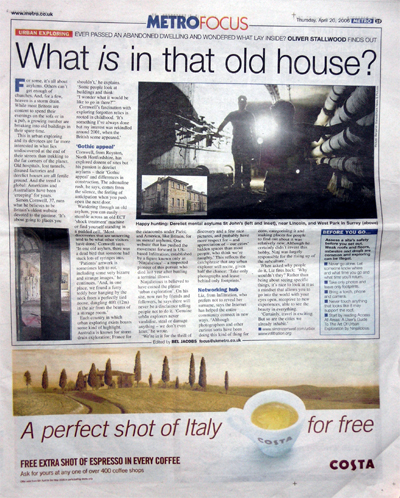What is in that old house?
For some it’s all about asylums. Others can’t get enough of churches. And for a few, heaven is a
storm drain. While most Britons are content to spend their evenings on the sofa or in a pub, a growing
number are breaking into old buildings in their spare time.
This is urban exploring and its devotees are far more interested in what lies undiscovered at
the end of their streets than trekking to the far corners of the planet. Old hospitals, lost
tunnels, disused factories and derelict houses are all fertile ground. And the trend is global:
Americans and Australians have been ‘creeping’ for years.
Simon Cornwell, 37, runs what he believes to be Britain’s oldest website devoted
to the pastime. ‘It’s about going to places you shouldn’t,’ he explains. ‘Some people look at buildings
and think: “I wonder what it would be like to go in there?”
Cornwell’s fascination with exploring forgotten relics is rooted in
childhood. “It’s something I’ve always done but my interest was rekindled around 2001,
when the British scene appeared.”
Cornwell, from Royston, North Hertfordshire, has explored dozens of sites
but his passion is derelict asylums – their ‘Gothic appeal’ and differences in construction.
The adrenaline rush, he says, comes from the silence, the feeling of anticipation when you push
open the door.
Wandering through an old asylum you can easily stumble across an old ECT ‘shock treatment’ machine
or find yourself standing in a padded cell. ‘Most discoveries that are unnerving tend to be what
other visitors have done,’ Cornwell says. ‘In one old asylum, there was a dead
bird that someone had stuck lots of syringes into.
‘Patients’ artwork is sometimes left to rot, including some very bizarre and strange images,’
he continues. ‘And in one place, we found a furry teddy bear hanging by the neck from a perfectly
tied noose, dangling 40ft (12m) in the air from the beams of a storage room.’
Each country in which urban exploring exists boasts some kind of highlight. Australia is known for
storm drain exploration; France for the catacombs under Paris’ and America, like Britain, for its
mental asylums. One website that has pushed the movement forward is US-based
Infiltration,
established by a figure known only as Ninjalicious – a respected pioneer of this pursuit who died
last year after battling a terminal illness.
Ninjalicious is believed to have coined the phrase ‘urban exploration’. On his site,
now run by friends and followers, he says there will never be a disclaimer telling people not to do it.
‘Genuine urban explorers never vandalise, steal or damage anything – we don’t even litter,’ he wrote.
‘We’re in it for the thrill of discovery and a few nice pictures, and probably have more respect for – and
appreciation of – our cities’ hidden spaces than most people, who think we’re naughty.’ This reflects the
catchphrase that any urban explorer will recite, given half the chance: ‘Take only photographs and
leave behind only footprints.’
Liz, from Infiltration, who prefers not to reveal her surname,
says the Internet has helped the entire community connect in new ways. ‘Although photographers and
other curious sorts have been doing this kind of thing for eons, categorising it and making
places for people to find out about it was relatively new. Although he certainly didn’t
invent this hobby, Ninj was largely responsible for the rising up of the subculture.’
When asked why people do it, Liz fires back: ‘Why wouldn’t they? Rather than being
about seeing specific things, it’s nice to look at it as a mindset that allows you to go into
the world with your eyes open, receptive to new experiences, able to see the beauty in everything.
‘Certainly travel is exciting. But so are the cities we already inhabit.
www.simoncornwell.com/urbex
www.infiltration.org
picture caption: Derelict mental asylums St. John’s (left and inset), near Lincoln, and West Park in Surrey (above)
BEFORE YOU GO...
- Assess a site's safety before you set out.
- Weak roofs and floors, asbestos and drops are common and exploring can be illegal.
- Never go alone. Let someone know where and what time you go and what time you'll return.
- Take only photos and leave only footprints.
- Bring a torch, phone and camera.
- Never touch anything that looks like it may support the roof.
- Start by reading Access All Areas: A User's Guide To The Art Of Urban Exploration by Ninjalicious.




